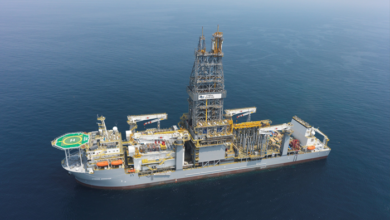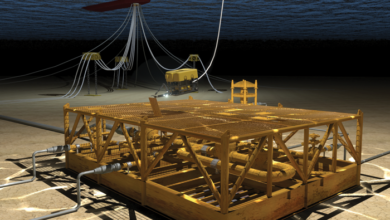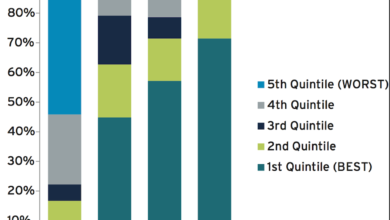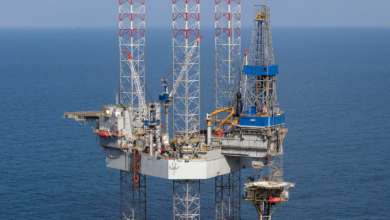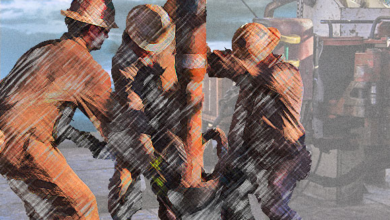Another rough year ahead for North American shale producers and drilling contractors, but 2017 could be a year of recovery
The bottom may be in sight, with oil prices potentially climbing to $60 by late 2016
By Kelli Ainsworth, Editorial Coordinator
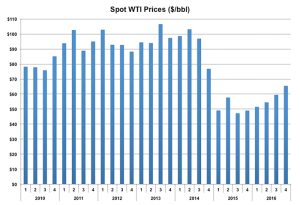
While 2016 is expected to be another rough year for North American shale drilling, rig counts and activity declines are projected to be much less severe than the reductions seen in 2015. “It’s pretty clear we’re close to an equilibrium in terms of rig count in the United States,” Timothy L. Dove, President and COO of Pioneer Natural Resources, said. “We continue to see small weekly reductions, but basically we’re reaching the bottom of where I think the rig count’s going to go.”
The decline in North American drilling activity this year has fallen unevenly on the shale plays. “The biggest declines have been where oil development has dominated, and that’s just a function of the fact that oil prices are down a little more than 50% this year,” said John Spears, President of Spears and Associates. “Gas prices are down, but they’re not down as sharply.” Oil-rich plays, such as the Permian, Eagle Ford and Bakken, have experienced 50% declines in activity, whereas the Marcellus declined only by about 25%. In 2016, he said he expects the relationship between commodity prices and breakeven prices to be about the same for both oil and gas shale plays. As a result, the change in drilling activity in oil shales and gas shales should be similar.
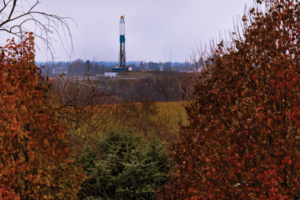
“Next year, I think the various shale plays will tend to move together,” he predicted, adding the decline in new wells drilled is expected to range between 10-15% across the board. In terms of the rig count, he is forecasting an average of 870, which would be a 13% decline from this year’s expected average of 1,000.
Spending is expected to decline by 15%, which Mr Spears attributes in part to contractors and service companies reducing rates and, therefore, costs for operators. However, some degree of spending reduction is also due to operators choosing to focus only on the best, most prolific zones in their core plays, where returns are highest. Further, operators have reduced their costs through technological and process changes that have increased efficiency and reduced drilling times.
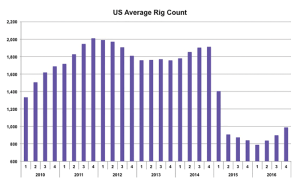
Overall, he added, breakevens are currently at approximately $40 in most plays, and this has been made possible in large part because of the fleet high-grading in which drilling contractors have invested. “So the elements are in place to support a recovery in drilling activity if we can get the prices to come up from where they are today.”
By late 2016, Mr Spears said he expects oil prices to approach $60, which should result in a 15-20% increase in rig activity through 2017. “We think 2016 will be pretty slow, but 2017 will be more of a recovery year for operators in the US.”
When recovery does begin, however, the industry is likely to look somewhat different than before the downturn. Some companies will have divested non-core plays or business units, while others will have expanded through acquisitions and/or mergers, David Witter, Industry Research Analyst for research firm IBISWorld, said. Some may even have been broken up and sold for parts. Look at exploration company Samson Resources, which filed for Chapter 11 bankruptcy in September. It “shows that even the large companies are having to face the reality that the oil price may remain low for an extended period of time,” Mr Witter said. “Companies that might have been thinking they could weather the storm are now having to look at alternatives and reevaluate their current positions.”
Emerging stronger

When an improved commodity price begins to drive activity upwards again, Mr Dove of Pioneer Natural Resources said, he expects the oily plays and the more prolific gas plays, such as the Marcellus and Utica, to be the first to see rig counts climb. For Pioneer specifically, plans are to add rigs to the Midland basin in Permian, as well as the Eagle Ford. In June, the operator announced its plans to add an average of two horizontal rigs per month in the Spraberry and Wolfcamp areas of the Permian from July 2015 through Q1 2016. In addition, the company will add an average of two rigs per month in the Eagle Ford in Q1 2016. “We’re planning to add rigs gradually, which would allow us to meet our longer-term growth profile, which is about a 15% growth rate per year over the next three years,” Mr Dove said.
One area Mr Dove does not see much potential for growth is in the vertical rig count, which currently stands at only 78. These rigs are primarily used to drill and uphold continuous development obligations on a handful of vertical leases, which require wells to be drilled every 120 or 180 days. “That’s probably one of the only reasons vertical wells are even being utilized today,” Mr Dove said, citing the lower returns on vertical wells compared with horizontal wells.
There are currently an estimated 520 vertical rigs idle, he added, and any of these that are brought back will be among the last rigs to return to work. “The vertical rigs will demand a higher (oil) price to come back to work because vertical wells are less prolific. They need a higher price to be drilled.”
A number of these vertical rigs are likely to be taken off the market entirely as North American companies move further away from vertical drilling. “It seems to me that a lot of these older units will eventually be scrapped,” Mr Spears said. “There just won’t be sufficient demand to warrant the cost. A lot of old units that were only suited to drilling vertical wells are going to go by the wayside.” It is possible these rigs could find work outside North America, however, as could older horizontal rigs. “I think we’ll see some of them find a second career in foreign markets as operators overseas begin to develop some of their shales.”
In the US, where the cost to drill unconventional wells is higher, Pioneer has been able to reduce costs through lower prices from contractors and service providers. Mr Dove said service costs had fallen by 25% as of October, and he expects a further 5-30% reduction by the end of the year.
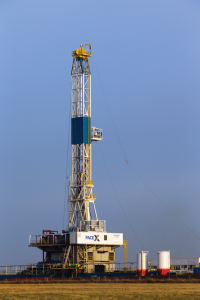
Efficiency has become critical this year, as well. In horizontal wells drilled in the Permian this year, Pioneer has been able to decrease its average drilling time from 30 days per well to 15 days, while some wells have been drilled in just 9.5 days. Some of this improvement has been driven through new casing designs that reduce the number of strings needed for each well. In addition, once the market downturn set in, Pioneer started directing its focus to just one zone, the Wolfcamp B in the Permian. “If we have a crew on a rig that’s drilling just Wolfcamp B wells and they have the same challenges on each well, they get very good at dealing with those challenges,” Mr Dove said. “By the time they’ve drilled several wells, they have it down and can begin the process of cutting down the time it takes to drill a well.”
While service costs are likely to go up again when the oil price returns, efficiency gains such as these will remain. That will leave the industry in a stronger position than before oil prices dropped, Mr Dove said. “It’s one of the silver linings that’s associated with a downturn, that you can actually improve how you do things, and companies and the industry emerge better off after the downturn than when they went into it.”
Concerns for the upturn
Finding ways to help operators keep costs low, especially in plays that are just on the cusp of being profitable at lower oil prices, has been a top priority for Nabors, said Denny Smith, Director of Corporate Development and Investor Relations. “Everybody’s under a lot of pressure to get the breakeven costs reduced. Some of these basins are only marginally economic, or on the cusp of becoming economic,” he said. “If they become economic, that’s in everybody’s interest. We’re working with a lot of our customers on a multitude of initiatives to do exactly that.”
One of Nabors’ recent efforts has revolved around reducing move times for the PACE-X rig, its latest-generation rig designed for high-density pad drilling. When the rigs were first introduced, they were already designed to move quickly and efficiently within single pads. Operators then started pushing for better performance in moving the rigs between different pads. So Nabors reconfigured its trucking plans so that fewer loads are required, and the contractor has been able to complete PACE-X rig moves between pads in as little as 2.5 days across all US shale plays, Mr Smith said. “We’ve had a real concerted effort on move planning and organization to reduce those moving times.”
Mr Smith said he’s also looking to prepare for the next upturn. When prices rebound and activity picks up, recruiting new personnel will quickly become a critical challenge. “The labor pool is probably still resilient out there with a lot of experienced people, but as more time goes by, they’ll migrate to other opportunities and may be reluctant to come back,” he said. Aside from attractive compensation and benefits, the key factors that will bring talent back into the industry, he said, is a culture that make personnel feel safe and valued.
Bringing rigs back online will be another concern, especially if they require any maintenance work. “There are probably a lot of service companies and contractors that are deferring maintenance on idle equipment,” Mr Smith said. “Parts of the industry are likely to incur significant capital cost to bring that equipment back into service when a recovery progresses.”
If the recovery is gradual, these challenges will be somewhat easier to meet. However, “the sharper the increase in activity, the more these challenges manifest themselves.”
Out of its fleet of 205 US land rigs, Nabors had 88 working as of September. The company is also planning to complete eight newbuild PACE-X rigs for the US lower 48 market over the next year. At this time, none of the rigs have contracts, and it’s possible that Nabors will market these rigs abroad.
In addition to these newbuilds from Nabors, there are a handful of other new rigs expected for the North American tight oil market, but overall the orderbook is shrinking, Mr Spears said, and it will likely be two or more years before any more are ordered. “There are a lot of good rigs that are pretty new on the sidelines right now. Only after those rigs are back up and running, then we will see a newbuild market emerge again.” DC
- Oil-rich plays such as the Permian, Eagle Ford and Bakken have experienced 50% declines in activity, whereas the gas-heavy Marcellus declined only by about 25%.
- The reduction in new wells drilled is expected to range between 10-15% across the board in 2016.
- In 2016, the North American land rig count is expected to average 870, which would be a 13% decline from 2015’s expected average of 1,000.
- Spending on North American shale projects is expected to decline by 15% in 2016.
- Breakevens are currently at approximately $40 in most US shale plays.
- Oil prices are expected to reach $60 in late 2016, which should result in a 15-20% increase in rig activity through 2017.
- Pioneer plans to add rigs incrementally to the Eagle Ford and Permian in order to achieve their targeted growth rate of 15% per year.
- Pioneer’s service costs had fallen by 25% as of October, and the company expects a further 5% to 30% reduction by the end of the year.
- Pioneer has been able to decrease its average drilling time per well from 30 days to 15 days in the Permian.
- Nabors’ PACE-X rigs can now move between pads in as little as 2.5 days across all US shale plays.

